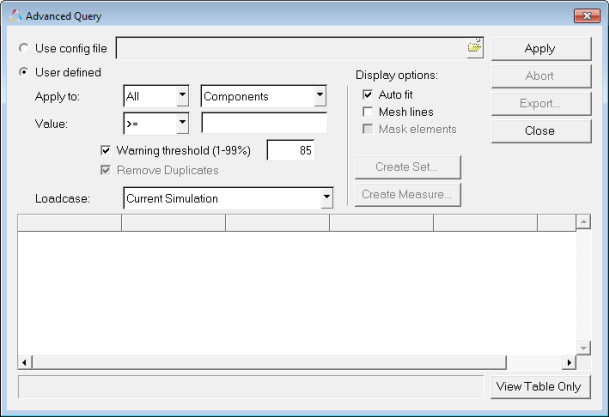Advanced Query Dialog |

|

|

|

|
|
Advanced Query Dialog |

|

|

|

|
From the Query panel, click Advanced… to display the Advanced Query dialog. This option is available after you apply a contour plot to your model. From the Advanced Query dialog, you can input additional query options beyond what is available on the main Query panel.

Advanced Query dialog
Part bound results are also supported in Advanced Query. Using Result Math to create expressions for part summations or max/min, the Advanced Query can be looped through the entire model and all loadcases to find the Top N/Bottom N ranked parts.
The following options are available:
Use config file |
Use the file browser button to select a text file containing specific keywords. The text file must contain the following keywords: |
|||||||||||
|
TYPE |
Supported types are component, node, and element. |
||||||||||
|
OPERATOR |
Supported operators are >=, and <=. |
||||||||||
|
PERCENTAGE |
A positive integer between 0 and 100. |
||||||||||
|
LOADCASE |
Possible values are "current simulation", "current loadcase", and "all loadcases". |
||||||||||
|
ID |
The entity ID. |
||||||||||
|
YIELD |
The yield value. |
||||||||||
|
Lines that start with the "#" sign are considered comments and are ignored. Click here to see a sample config file for the advanced query control. |
|||||||||||
User defined |
When using the User defined option, make selections from the following options: |
|||||||||||
|
Apply to |
From the first drop-down menu, select All to apply the query to all entities. Select Displayed to apply the query to only the displayed entities. From the second drop-down menu, select the entity type on which you want to query. Possible entity types include Components and Elements if the data type binding is elemental, or Components and Nodes if the data type binding is nodal. |
||||||||||
|
Value |
From the first drop-down menu, select a parameter from the list. If the entity type is set to Components, the options include the following operators:
If the entity type is set to Elements or Nodes, the options include the >= and <= operators, plus:
These two options allow you to display only a certain number of entities in the table. For example, if you are querying elements, and the query returns 1000 elements, then you can set the top 500 elements to be reported in the table. Enter a value in the text field next to the drop-down menu. This value can be a real or decimal number if the operator is set to >= or <=. If the operator is set to Top N or Bottom N, the value must be a positive decimal number. |
||||||||||
|
Remove duplicates |
Removes all duplicates from the queried nodal data. This option is enabled when either:
OR
Note - This option is disabled for all query entity types other than node. |
||||||||||
|
Warning threshold |
A positive decimal number between 1 and 99. |
||||||||||
|
Loadcase |
Select Current Simulation, Current Loadcase, or All Loadcases. This determines whether to apply the query to the current simulation step, or to cycle through all simulation steps and possible all loadcases available. |
||||||||||
Apply |
Click Apply to apply your settings and start the query. Visual feedback is provided through a progress bar at the bottom of the dialog. The acquired data is displayed in a table. Based on the entity type, the table consists of different columns. Data can be sorted in the table by clicking on the header cells. When clicking on a colored cell, the corresponding component/node/element is displayed in the window. See Display Options. After the acquired data is displayed in the table, contour plot information is displayed in the status bar area. |
|||||||||||
Abort |
Click Abort to stop the search mid-query. This button is disabled unless a query is being performed. |
|||||||||||
Export |
You can export data from the table to a .csv or HTML file. Click Export to display the Export Options dialog. For Report type, select CSV or HTML. In the Author field, enter the author's name. The default value is the user name assigned to your computer. Enter comments or notes in the Description field. Both the CSV and HTML formats contain the following information added to the collected data as a header followed by the information available in the table: See Exporting Advanced Query Data to an HTML File for more information. |
|||||||||||
Close |
Click Close to close the dialog, clear the table contents, and return to the Query panel. HyperView also restores the original display list that the model had upon entering the Advanced Query dialog. |
|||||||||||
View Table Only |
Displays only the table and hides the upper part of the dialog. |
|||||||||||
Normal View |
Click to return to the previous view. |
|||||||||||
Display Options |
The display options apply when you select a colored cell in the table to view components. |
|||||||||||
|
Auto fit |
HyperView automatically fits the view after displaying the component. |
||||||||||
|
Mesh lines |
The component is displayed with the mesh mode on. |
||||||||||
|
Mask Elements |
This option is only available when querying elements. Only reported elements in the part/component are shown, all other elements are masked. |
||||||||||
Create Set |
Select this to create a set (group) of entities, which have been queried. Enter a name in the Group Label dialog to create the set (group). A default label is provided. You can also create a set (group) of entities using the Set panel. |
|||||||||||
Create Measure |
Select this to create a measure. All reported nodes/elements are added to the measure. Enter a name in the Measure Label dialog to create the measure. A default label is provided. |
|||||||||||